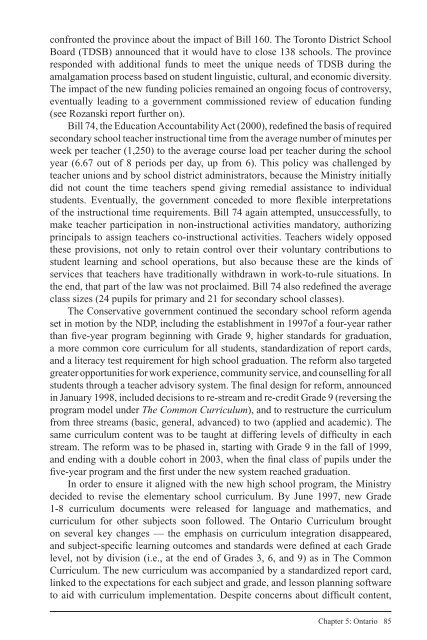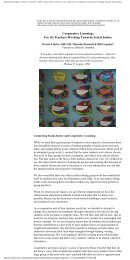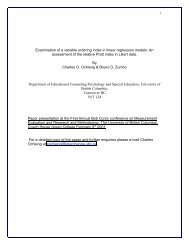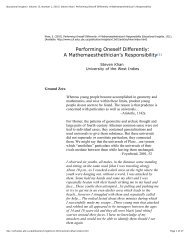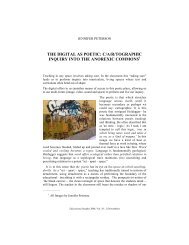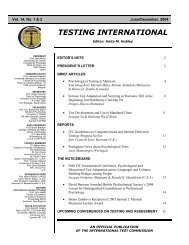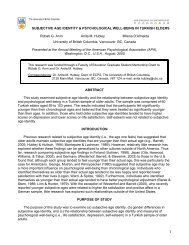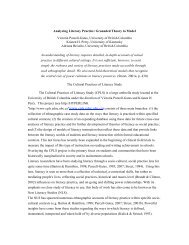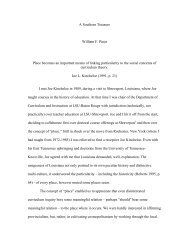The evolution of professionalism - Centre for Policy Studies in ...
The evolution of professionalism - Centre for Policy Studies in ...
The evolution of professionalism - Centre for Policy Studies in ...
You also want an ePaper? Increase the reach of your titles
YUMPU automatically turns print PDFs into web optimized ePapers that Google loves.
confronted the prov<strong>in</strong>ce about the impact <strong>of</strong> Bill 160. <strong>The</strong> Toronto District School<br />
Board (TDSB) announced that it would have to close 138 schools. <strong>The</strong> prov<strong>in</strong>ce<br />
responded with additional funds to meet the unique needs <strong>of</strong> TDSB dur<strong>in</strong>g the<br />
amalgamation process based on student l<strong>in</strong>guistic, cultural, and economic diversity.<br />
<strong>The</strong> impact <strong>of</strong> the new fund<strong>in</strong>g policies rema<strong>in</strong>ed an ongo<strong>in</strong>g focus <strong>of</strong> controversy,<br />
eventually lead<strong>in</strong>g to a government commissioned review <strong>of</strong> education fund<strong>in</strong>g<br />
(see Rozanski report further on).<br />
Bill 74, the Education Accountability Act (2000), redefi ned the basis <strong>of</strong> required<br />
secondary school teacher <strong>in</strong>structional time from the average number <strong>of</strong> m<strong>in</strong>utes per<br />
week per teacher (1,250) to the average course load per teacher dur<strong>in</strong>g the school<br />
year (6.67 out <strong>of</strong> 8 periods per day, up from 6). This policy was challenged by<br />
teacher unions and by school district adm<strong>in</strong>istrators, because the M<strong>in</strong>istry <strong>in</strong>itially<br />
did not count the time teachers spend giv<strong>in</strong>g remedial assistance to <strong>in</strong>dividual<br />
students. Eventually, the government conceded to more fl exible <strong>in</strong>terpretations<br />
<strong>of</strong> the <strong>in</strong>structional time requirements. Bill 74 aga<strong>in</strong> attempted, unsuccessfully, to<br />
make teacher participation <strong>in</strong> non-<strong>in</strong>structional activities mandatory, authoriz<strong>in</strong>g<br />
pr<strong>in</strong>cipals to assign teachers co-<strong>in</strong>structional activities. Teachers widely opposed<br />
these provisions, not only to reta<strong>in</strong> control over their voluntary contributions to<br />
student learn<strong>in</strong>g and school operations, but also because these are the k<strong>in</strong>ds <strong>of</strong><br />
services that teachers have traditionally withdrawn <strong>in</strong> work-to-rule situations. In<br />
the end, that part <strong>of</strong> the law was not proclaimed. Bill 74 also redefi ned the average<br />
class sizes (24 pupils <strong>for</strong> primary and 21 <strong>for</strong> secondary school classes).<br />
<strong>The</strong> Conservative government cont<strong>in</strong>ued the secondary school re<strong>for</strong>m agenda<br />
set <strong>in</strong> motion by the NDP, <strong>in</strong>clud<strong>in</strong>g the establishment <strong>in</strong> 1997<strong>of</strong> a four-year rather<br />
than fi ve-year program beg<strong>in</strong>n<strong>in</strong>g with Grade 9, higher standards <strong>for</strong> graduation,<br />
a more common core curriculum <strong>for</strong> all students, standardization <strong>of</strong> report cards,<br />
and a literacy test requirement <strong>for</strong> high school graduation. <strong>The</strong> re<strong>for</strong>m also targeted<br />
greater opportunities <strong>for</strong> work experience, community service, and counsell<strong>in</strong>g <strong>for</strong> all<br />
students through a teacher advisory system. <strong>The</strong> fi nal design <strong>for</strong> re<strong>for</strong>m, announced<br />
<strong>in</strong> January 1998, <strong>in</strong>cluded decisions to re-stream and re-credit Grade 9 (revers<strong>in</strong>g the<br />
program model under <strong>The</strong> Common Curriculum), and to restructure the curriculum<br />
from three streams (basic, general, advanced) to two (applied and academic). <strong>The</strong><br />
same curriculum content was to be taught at differ<strong>in</strong>g levels <strong>of</strong> diffi culty <strong>in</strong> each<br />
stream. <strong>The</strong> re<strong>for</strong>m was to be phased <strong>in</strong>, start<strong>in</strong>g with Grade 9 <strong>in</strong> the fall <strong>of</strong> 1999,<br />
and end<strong>in</strong>g with a double cohort <strong>in</strong> 2003, when the fi nal class <strong>of</strong> pupils under the<br />
fi ve-year program and the fi rst under the new system reached graduation.<br />
In order to ensure it aligned with the new high school program, the M<strong>in</strong>istry<br />
decided to revise the elementary school curriculum. By June 1997, new Grade<br />
1-8 curriculum documents were released <strong>for</strong> language and mathematics, and<br />
curriculum <strong>for</strong> other subjects soon followed. <strong>The</strong> Ontario Curriculum brought<br />
on several key changes — the emphasis on curriculum <strong>in</strong>tegration disappeared,<br />
and subject-specifi c learn<strong>in</strong>g outcomes and standards were defi ned at each Grade<br />
level, not by division (i.e., at the end <strong>of</strong> Grades 3, 6, and 9) as <strong>in</strong> <strong>The</strong> Common<br />
Curriculum. <strong>The</strong> new curriculum was accompanied by a standardized report card,<br />
l<strong>in</strong>ked to the expectations <strong>for</strong> each subject and grade, and lesson plann<strong>in</strong>g s<strong>of</strong>tware<br />
to aid with curriculum implementation. Despite concerns about diffi cult content,<br />
Chapter 5: Ontario 85


